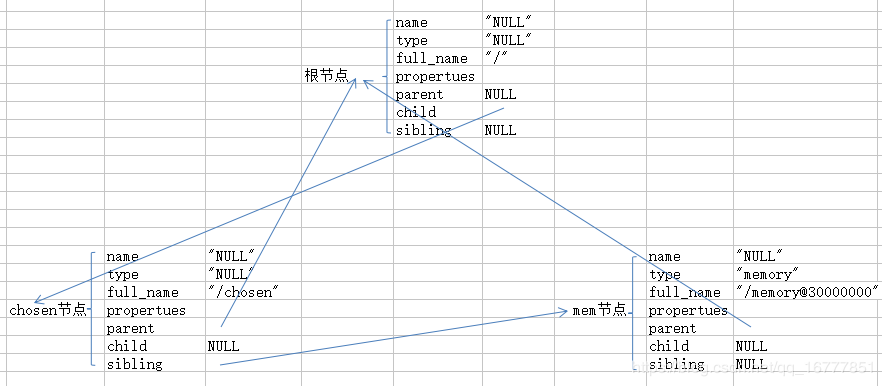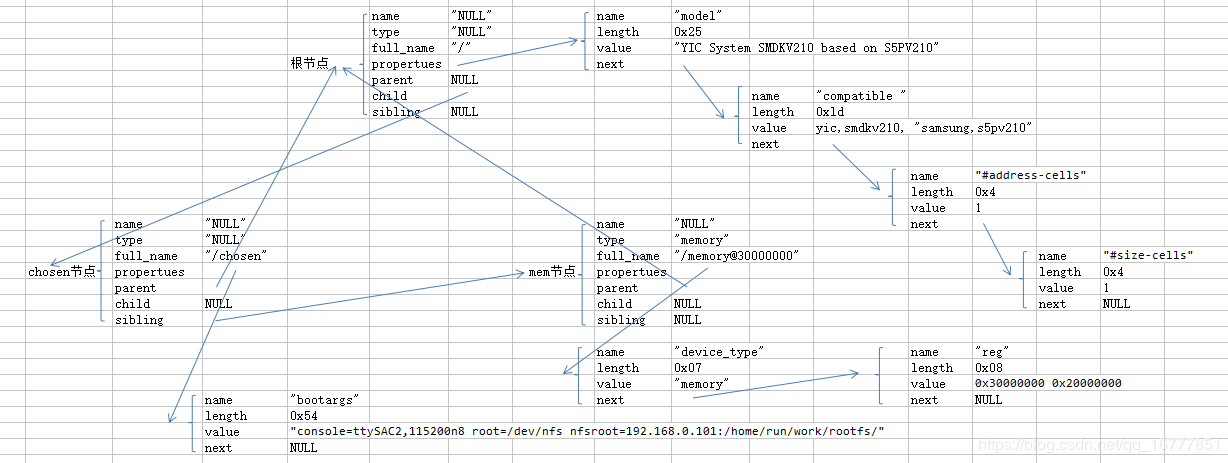1.内核中对一个设备节点的表示
struct device_node {
const char *name; //节点的名字
const char *type; //device_type属性的值
phandle phandle; //对应该节点的phandle属性
const char *full_name; //节点的名字, node-name[@unit-address]从“/”开始的,表示该node的full path
struct fwnode_handle fwnode;
struct property *properties; // 节点的属性
struct property *deadprops; /* removed properties 如果需要删除某些属性,kernel并非真的删除,而是挂入到deadprops的列表 */
struct device_node *parent; // 节点的父亲
struct device_node *child; // 节点的孩子(子节点)
struct device_node *sibling; // 节点的兄弟(同级节点)
#if defined(CONFIG_OF_KOBJ) // 在sys文件系统表示
struct kobject kobj;
#endif
unsigned long _flags;
void *data;
#if defined(CONFIG_SPARC)
const char *path_component_name;
unsigned int unique_id;
struct of_irq_controller *irq_trans;
#endif
};
从这里我们就可以看到一个设备节点的大概组织形式了。通过下面这三个组织成一个树形结构。
struct device_node *parent; // 节点的父亲 struct device_node *child; // 节点的孩子(子节点) struct device_node *sibling; // 节点的兄弟(同级节点)
device_node结构体中有properties, 用来表示该节点的属性
struct property {
char *name; //属性名字
int length; //value的长度
void *value; //属性值
struct property *next; //指向统一节点的下一个属性
#if defined(CONFIG_OF_DYNAMIC) || defined(CONFIG_SPARC)
unsigned long _flags;
#endif
#if defined(CONFIG_OF_PROMTREE)
unsigned int unique_id;
#endif
#if defined(CONFIG_OF_KOBJ)
struct bin_attribute attr;
#endif
};
2.举例说明
/dts-v1/;
/memreserve/ 0x4ff00000 0x100000;
/ {
model = "YIC System SMDKV210 based on S5PV210";
compatible = "yic,smdkv210", "samsung,s5pv210";
#address-cells = <1>;
#size-cells = <1>;
chosen {
bootargs = "console=ttySAC2,115200n8 root=/dev/nfs nfsroot=192.168.0.101:/home/run/work/rootfs/";
};
memory@30000000 {
device_type = "memory";
reg = <0x30000000 0x20000000>;
};
};
下图表示上面的根节点和其里面的两个子节点。

接下来向里面填充属性值
首先是把根节点里的4个属性进行填充

在添加上其它两个节点的属性后如下。
